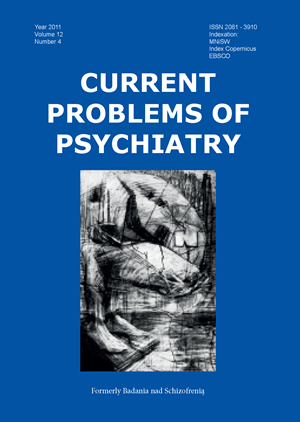Kynurenic acid and positive symptoms in schizophrenia
Keywords:
kynurenic acid, schizophrenia, positive symptomsAbstract
Kynurenic acid (KYNA) is a neuroactive metabolite of tryptophan that is synthesized in the brain mainly by astrocytes. Growing evidence indicates an anticonvulsant and neuroprotective role of KYNA. Differences in kynurenic acid concentration are described in the course of diseases such as Alzheimer’s disease, Parkinson’s disease, Huntington’s disease, epilepsy, depression, anxiety disorder or schizophrenia. Progress in the field of schizophrenia research points out that dopamine plays only an intermediary role in the pathogenesis of the disease and that there is a necessity forfinding a source of this disorders in relation to other neurotransmitters, in particular as far as the glutamatergic system is concerned. In reference to searching for the pathogenesis of positive symptoms in schizophrenia, it is vital to find an element linking dopaminergic hyperactivity with glutamatergichypoactivity. KYNA is a nonselective antagonist of ionotropic receptors for excitatory aminoacids: NMDA receptor, kainic acid receptor, AMPA receptor. Moreover, KYNA is an antagonist of an independent of strychnine glicyne site of the NMDA receptor complex. Recent research indicates that cerebrospinal fluid level of KYNA is elevated in schizophrenic patients. Pharmacologically elevated level of KYNA leads to increased dopaminergic activity of the neurons in the rat ventral tegmental area. Research provides evidence that KYNA has inhibiting influence on glutamate release. Elevated level of KYNA causes an effect similar to the effect demonstrated after administration of ketamine or phencyclidine and is associated with psychomimetic effects. To sum up, the raised dopaminergic activity in the mesolimbic system and glutamatergic hypoactivity play an important role in pathogenesis of positive symptoms in schizophrenia and KYNA is a modulator of both of these mechanisms.
References
1. Turski W., Dekundy A. Kwas kynureninowy – rola w fizjologii i patologii ośrodkowego układu nerwowego. Farmacja Polska, 2000; 56(9): 449-453.
2. Stone T.W. Kynurenines in the CNS: from endogenous obscurity to therapeutic importance. Prog. Neurobiol., 2001; 64: 101-108.
3. Baran H., Jellinger K., Deecke L. Kynurenine metabolism in Alzheimer’s disease. J. Neural.Transm., 19999; 106(2): 165-181.
4. Beal M.F., Matson W.R., Story E., Milbury P., Ryan E.A., Ogawa T., Bird E.D., Kynurenic acid concentrationsare reduced in Hunting-ton’s disease cerebral cortex. J. Neurol. Sci. 1992; 108(1): 80-87.
5. Beal M.F., Matson W.R., Swartz K.J., GamacheP.H.,Bird E.D., Kynurenine pathway measurements in Huntington’s disease striatum: evidence for reduced formation of kynurenic acid. J.Neurochem. 1990; 55(4): 1327-1339.
6. Connick J.H., Carla V., Moroni F., Stone T.W., Increase in kynurenic acid in Huntington’s disease motor cortex. J.Neurochem. 1989; 52(3): 985-987.
7. Myint A.M., Kim Y.K., Verkerk R., Scharpe S., Steinbusch H., Leonard B., Kynurenine pathway in major depression: evidence of impaired neuroprotection. J. Affect. Disord., 2007; 98(1-2): 143-151.
8. Olajossy M., Poziom kwasu kynureninowego w surowicy krwi chorych na depresję leczonych elektrycznie. Rozprawa habilita-cyjna, Lublin,2010.
9. Erhardt S., Blennow K., Nordin C., Skogh E., Lindström L.H., Engberg G. Kynurenic acid levels are elevated in the cerbrospinal fluid of patients with schizophrenia. Neurosci. Lett. 2001; 313: 96-98.
10. Moroni F., Russi P., Lombardi G., Beni M., Carla V. Presence of kynurenic acid in the mammalian brain. J.Neurochem., 1988; 51(1): 177-180.
11. Turski W.A., Nakamura M., Todd W.P., Carpenter B.K., Whetsell W.O. Jr, Schwarcz R. Identification and quantification of kynurenic acid in human brain tissue. Brain Res., 1988; 454(1-2): 164-169.
12. Cannaza G., Chiarugi A., Parenti C., Zanoli P., Baraldi M. Changes in kynurenic, anthranilic, and quinolinic acid concentration in rat brain tissue during development. Neurochem. Res., 2001; 26: 511-514.
13. Rossi F., Schwarcz R., Rizzi M. Curiosity to kill the KAT (kynurenine aminotransferase): structural insights into brain kynurenic acid synthesis. Curr. Opin. Struct.Biol., 2008; 18: 748-755.
14. Turzyńska D., Szyndler J., Maciejak P., Sobolewska A., Płaźnik A. Kwas kynureninowy – neuroprotekcyjna substancja w chorobach ośrodkowego układu nerwowego. Postępy Psychiatrii i Neurologii, 2010; 19(1): 61-72.
15. Wciórka J. Psychozy schizofreniczne. W: Bilikiewicz A. red., Psychiatria. wyd. 2. zmienioneiuzupełnione, Warszawa; PZWL: 2009, s. 270-309.
16. Carlsson A Lindqvist M. Effects of chlorpromazine or haloperidol on formation of 3-methoxytyramine and normetanephrinein mouse brain. ActaPharm.Toxicol., 1963; 20: 140-144.
17. Müller N. Inflamation and the glutamate system in schizophrenia: implications for therapeutic targets and drug development. Expert. Opin. Ther. Targets, 2008; 12(12): 1497-1507.
18. Erhardt S., Schwieler L., Nilsson L., Linderholm K., Engberg G. The kynurenic acid hypothesis of schizophrenia. Physiol. Behav., 2007; 92: 203-209.
19. Erhardt S., Engberg G. Increased phasic activity of dopaminergic neurons in the rat ventral tegmental area following pharmacologically elevated levels of endogenous kynuretic acid. ActaPhysiol. Scand., 2002; 175: 45-53.
20. Poeggler B., Rassoulpour A., Wu H.Q., Guidetti P., Roberts R.C., Schwarcz R. Dopamine receptor activations reveals a novel, kynurenate-sensitive component of strial N-methyl-D-aspartate neurotoxicity. Neuroscience, 2007; 148(1): 188-197.
21. Condray R., Dougherty G.G. Jr., Keshavan M.S., Reddy R.D., Haas G.L., Montrose D.M., Matson W.R., McEvoy J., Kaddurah-Daouk R., Yao J.K. 3-hydroxykynurenine and clinical symptoms in first-episode neurolepticnaïve patients with schizophrenia. Int. J.Neuropsychofarmacol. 2011; 14 (6): 756-767.
Downloads
Published
Issue
Section
License
Copyright (c) 2011 Authors

This work is licensed under a Creative Commons Attribution-NonCommercial-NoDerivatives 3.0 Unported License.


